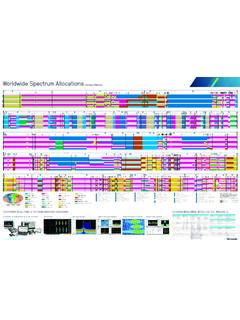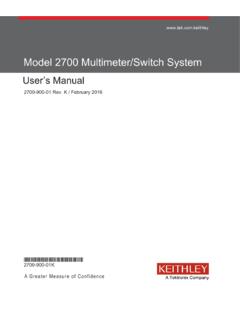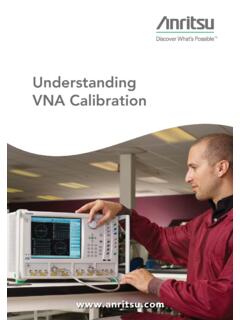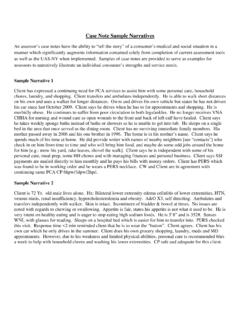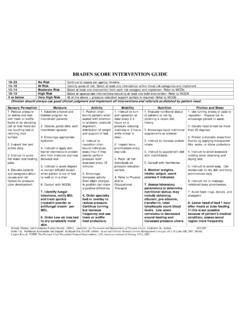Transcription of Introduction to VNA Basics - Tektronix
1 Introduction to VNA Basics . PRIMER. Introduction to VNA Basics PRIMER. The Vector network analyzer or VNA is an important test Contents instrument that has helped make countless modern wireless technologies possible. Today, VNAs are used in a wide range Vector Network Analyzer 3. of RF and high frequency applications. In design applications, simulations are used to accelerate time-to-market by reducing Who Needs a 4. physical prototype iterations. VNAs are used to validate Basic VNA 6. these design simulations. In manufacturing applications, RF Key 6. components or devices are assembled and tested based on VNA vs. Spectrum 8. a certain set of specifications. VNAs are used to quickly and Understanding 9. accurately validate the performance of these RF components and devices. Types of Measurement 11. Calibration 12. This paper discusses why VNAs are used and how they are unique compared to other RF test equipment. We'll define What is User 12.
2 S-Parameters, the fundamental VNA measurement, and how VNA Calibration 13. best to use them when evaluating your Device-Under-Test or Calibration 14. DUT. We'll review various VNA calibration techniques and show Typical VNA 15. how VNA user calibrations help achieve the best accuracy Swept Frequency 15. possible. Finally, we'll review typical VNA measurements such as swept frequency measurements, time domain Time Domain 16. measurements, and swept power measurements and how Swept Power 16. they're used and why they are important. Testing Multiport 17. 18. 2 | Introduction to VNA Basics PRIMER. Not for measuring Not for drive testing Not for computer WiFi networks mobile phone networks networks or clouds FIGURE 1. Today there are a wide variety of networks, each with its own network analyzer. The vector network analyzer, discussed in this document, is used for a different kind of network and was defined long before any of these networks existed.
3 Vector Network Analyzer Overview Tektronix 2016. Today, the term network analyzer , is used to describe tools for a variety of networks (Figure 1). For instance, most people today have a cellular or mobile phone that runs on a 3G or 4G network . In addition, most of our homes, offices and commercial venues all have Wi-Fi, or wireless LAN networks . Furthermore, many computers and servers are setup in FIGURE 2. Vector Network Analyzers or VNAs were invented in the 1950s and are actively used around the world today. networks that are all linked together to the cloud. For each of these networks , there exists a certain network analyzer tool used to verify performance, map coverage zones and identify problem areas. However, the network analyzer of interest in this paper is used for a different kind of network and was defined long before any of these networks existed. The first VNA was invented around 1950 and was defined as an instrument that measures the network parameters of electrical networks (Figure 2).
4 In fact, it can be said that the VNA has been used over the years to help make all the networks mentioned above possible. From mobile phone networks, to Wi-Fi networks, to computer networks and the to the cloud, all of the most common technological networks of today were made possible using the VNA that was first invented over 60 years ago. | 3. Introduction to VNA Basics PRIMER. FIGURE 3. VNAs are used to make most modern technologies possible. WHO NEEDS A VNA VNAs are used to test component specifications and verify All wireless solutions have transmitters and receivers, and each design simulations to make sure systems and their components contains many RF and microwave components. This includes work properly together. R&D engineers and manufacturing not only smartphones and WiFi networks, but also connected test engineers commonly use VNAs at various stages of cars and IoT (Internet of Things) devices. Additionally, computer product development.
5 Component designers need to verify the networks today operate at such high frequencies that they are performance of their components such as amplifiers, filters, passing signals at RF and microwave frequencies. Figure 3 antennas, cables, mixers, etc. The system designer needs shows a range of example applications that exist today with the to verify their component specs to ensure that the system help of VNAs. performance they're counting on meets their subsystem and system specifications. Manufacturing lines use VNAs to make sure that all products meet specifications before they're shipped out for use by their customers. In some cases, VNAs are even used in field operations to verify and troubleshoot deployed RF and microwave systems. 4 | Introduction to VNA Basics PRIMER. How much stronger will a signal be after the amplifier? How efficient is the antenna for transitioning the signal to/from the air? RF Front-End Up-Mixer Antenna Filter PA.
6 How well is the signal How much signal is being converted to a new getting to the antenna? frequency and are any Duplexer VCO. IF. unwanted signals being generated? How well is the transmit LNA Filter signal isolated from the receive signal? Down-Mixer How well are unwanted signals going to be filtered out? FIGURE 4. VNAs may be used to verify component, subsystem and system level performance. As an example, Figure 4 shows an RF system front end and From a system design point of view, how much signal goes how different components and parts of the system are tested through the RF board and out of the antenna? On the receive with a VNA. For the antenna, it is important to understand how side, how effective is the duplexer in providing isolation efficient the antenna is at transitioning the signal to and from between the transmit and the receive signal? All of these the air. As we'll explain later, this is determined by using a VNA questions can be answered using a VNA.
7 To measure the return loss or VSWR of the antenna. Looking at the right side of Figure 4, the up-mixer takes the IF signal and mixes it with an oscillator (VCO) to produce the RF signal. How well is the signal being converted to a new frequency? Are any unwanted signals being generated? What power levels are the most efficient at driving the mixer? VNAs are used to answer these questions. | 5. Introduction to VNA Basics PRIMER. FIGURE 5. VNAs contain both a stimulus source and receivers to provide a very accurate closed loop for evaluating DUTs. BASIC VNA OPERATION to a 2-port 2-path VNA, the DUT can be connected to either One unique feature of a VNA is that it contains both a source, port in either direction because the instrument has the used to generate a known stimulus signal, and a set of capability of reversing the signal flow so that the reflections at receivers, used to determine changes to this stimulus caused both ports (S11 and S22), as well as the forward and reverse by the device-under-test or DUT.
8 Figure 5 highlights the basic transmissions (S21 and S12), can be measured. operation of a VNA. For the sake of simplicity, it shows the KEY SPECIFICATIONS. source coming from Port 1, but most VNAs today are multipath instruments and can provide the stimulus signal to either port. When determining your needs for a VNA, there are several key specifications to consider. While there are many VNA. The stimulus signal is injected into the DUT and the VNA specifications, there are four top level specs which can be measures both the signal that's reflected from the input side, used to guide your selection process frequency range, as well as the signal that passes through to the output side of dynamic range, trace noise, and measurement speed. the DUT. The VNA receivers measure the resulting signals and compare them to the known stimulus signal. The measured Frequency range is the first and most critical specification to results are then processed by either an internal or external PC consider (Figure 6a).
9 For this, it is often good to consider not and sent to a display. only your immediate needs but also potential future needs. In addition, while all DUTs have a given operational frequency, for There are a variety of different VNAs available on the market, some DUTs you may need to consider harmonic frequencies each with a different number of ports and paths for which as well. Active components, such as amplifiers, converters and the stimulus signal flows. In the case of a 1-port VNA, the mixers may need to be tested at their harmonic frequencies DUT is connected to the input side of Figure 5 and only the which are 2 to 5 times operational frequency. Filters and reflected signals can be measured. For a 2-port 1-path VNA, duplexers may also need to be tested at harmonics of their both the reflected and transmitted signal (S11 and S21) can passband. Although a higher frequency range may be desired, be measured, however, the DUT must be physically reversed maximum frequency range can be a major cost driver for to measure the reverse parameters (S22 and S12).
10 As regards VNAs. 6 | Introduction to VNA Basics PRIMER. (a) Frequency Range (b) Dynamic Range (c) Trace Noise (d) Measurement speed FIGURE 6. Top level VNA specifications can be used to quickly determine the instrument class required for your application. Dynamic range is the measurable attenuation range from max ripple in the passband of a filter. If you need a certain level of to min for a specified frequency range (Figure 6b). Based performance to determine accuracy of a signal through a filter, on the desired performance of your DUT, you need to make the added VNA trace noise contribution may be a factor. sure that the magnitude of your maximum DUT attenuation Finally, one of the other specifications to consider is specifications are at least three to six dB less than the VNA. measurement speed (Figure 6d). Measurement speed is the dynamic range specification. Most VNAs today offer very time it takes to perform a single sweep or measurement.




